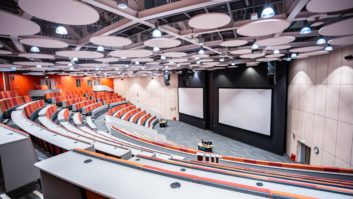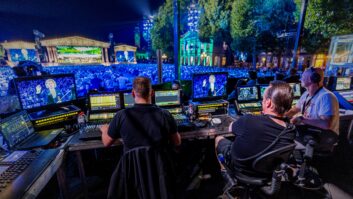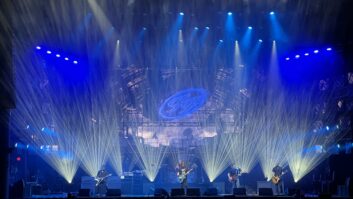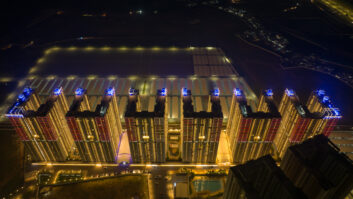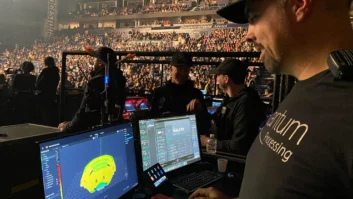Audio & video systems consultant Michael Hyland & Associates has designed an upgrade for Westminster Abbey. The project was completed ahead of the thanksgiving service to mark the 450th anniversary of Queen Elizabeth granting a Royal Charter to The Abbey in 1560.
The recent audio visual installation at The Collegiate Church of St Peter in Westminster (more usually known as Westminster Abbey) includes 80 of RCF’s compact CS 6940 2-way cardioid column loudspeakers. These provide coverage of the public areas and form part of an integration which includes speech reinforcement, induction loop and CCTV systems, along with video, audio and data distribution — designed by audio & video systems consultant Michael Hyland & Associates. The project was completed ahead of the thanksgiving service to mark the 450th anniversary of Queen Elizabeth granting a Royal Charter to The Abbey in 1560.
The RCF CS 6940 was designed specifically for speech reproduction with high intelligibility in acoustically-difficult environments, both indoors and outdoors, and is also suitable for music. Featuring eight round extended-range speakers and a tweeter, each speaker comes complete with line transformer for directly connecting the speaker columns to 100V constant-voltage systems. All have been spray painted in RAL 7006 to match the surrounding stonework (above).
The coverage has been divided into 47 loudspeaker zones. A number of presets enable the appropriate zones for the regular services to be selected via the touch-screens, a page on which displays a mimic of the building.
In one of the zones – the area between The Nave and The Quire – Martin Audio OmniLine micro-line array loudspeakers have been installed. Because of its discreet style and footprint, this unobtrusive system has become particularly popular in historic buildings and places of worship.
It had been noted that since the screen separating The Nave from The Quire acts as a form of acoustic barrier, it can be difficult for those seated in the Nave to hear the sound of the Choir — especially when the organ is being played loudly. By reinforcing the Choir sound with the OmniLines this problem has been solved.
The arrays are mounted at Organ Loft level — at each end of the Quire Screen balustrade. Each hang consists of eight modules — again, all spray painted (in RAL 7006, above) so that they blend discreetly into the pillars on which they are mounted.
The suspended microphones above the Quire Stalls provide the input signal to the OmniLines, with the system under the control of the organist.
Installation of the systems was implemented so that there was no impact whatever on the building’s daily services and the various other events for which The Abbey is used. Also, steps were taken to ensure that the work did not disrupt the routines which are in place to deal with the many visitors who tour The Abbey daily.
The installation of the audio, video and control systems was undertaken by Winchester-based Whitwam, whilst the cable installation was carried out by Thame-based Albert Walker Electrical. In fact a major part of the site work related to the cable requirements as new microphone, line level, loudspeaker, video and data circuits were installed throughout, with great care taken to conceal new cables and remove all redundant cabling where possible.
In order to reduce the length of the cable runs, equipment was decentralised and racks were installed at six key locations interlinked by a fibre backbone. In order to provide resilience and flexibility, two multicore fibres are installed between all rack locations, forming two continuous rings. Each rack contains a number of DSP units and control of the audio, video and related systems by the Vergers is by means of remote touch-screens.
In addition to the need for remotely located racks, limited space at ground floor level also had an impact. There are two user racks at ground floor level, located between The Nave and The Quire. A further two are at Organ Loft level, with a single rack in the South Transept and in the Nave Side Aisle — both at Triforium level. Smaller racks are located in the Henry VII Chapel and in The Cloister.
The system includes 32 cabled mic circuits set in key areas (identified via a building mimic on a separate page of the touch-screen) and six lapel radio mics, along with two stand mounted / hand held units.
A paging mic at the user rack enables ‘live’ announcements to be made throughout the building — the system also includes pre-recorded messages which take account of various emergency situations. Once the announcement is selected, it is automatically fed to all loudspeaker zones.
All seated areas of the building have induction loop coverage whilst CCTV coverage has been included by the use of pan / tilt / zoom colour cameras.
For major events, hired video monitors are temporarily installed to provide those in the side aisles and other areas with a better view of proceedings (these monitors are also used for events which are televised). In addition, at each location, there is an audio and a data circuit facilitating audio visual displays, interactive video, educational work stations and info display presentations.
Finally, the consultants’ design ties in ancillary areas to the core system such as:
• The Ringing Chamber — whereby a local loudspeaker enables the bell ringers to listen to the speech and music elements of the services and a video monitor enables them to see the output of the CCTV cameras;
• The Cloister – where equipment in this area provides a relay capability from The Abbey, and conversely cabled and radio mic facilities enable Cloister based events to be heard in The Abbey;
• St Margaret’s Church, which stands between The Abbey and the House of Commons, contains an audio link to the church’s own local sound system, enabling the relay of Abbey services to the church (notably The Abbey’s hourly prayers).
The entire project was carried out under the supervision of The Abbey’s Clerk of the Works. Since being commissioned, the system has been in use for the regular services, along with concerts, drama performances, lectures and TV broadcasts.
